A modern approach to visual brand identity
The nature of trends * The world has become different * Swear words * Farewell, familiar logo * End-to-end system of visual identification - what is it? * Decisive “no” palmistry * Open to fantasy * Learning to understand the client
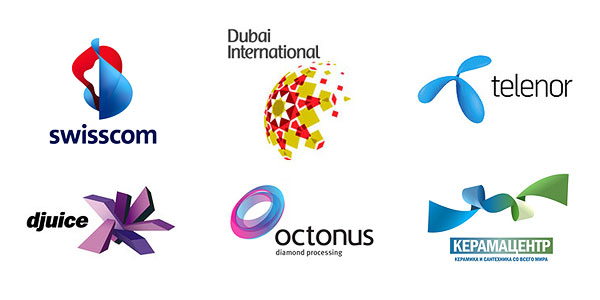
The world of domestic graphic design and visual branding is symbolic in its pursuit of trends. The tendencies of blind copying and imitation of the incomprehensible dominate in it. Most of the designers, marketers, creators in our country, unfortunately, are people without education and without roots. Everyone can become a prophet in the fatherland if the true nature of things remains open only to units - people who strive for knowledge.
How far we have gone into visual culture, it is easy to see on the examples of print advertising twenty-five years ago.
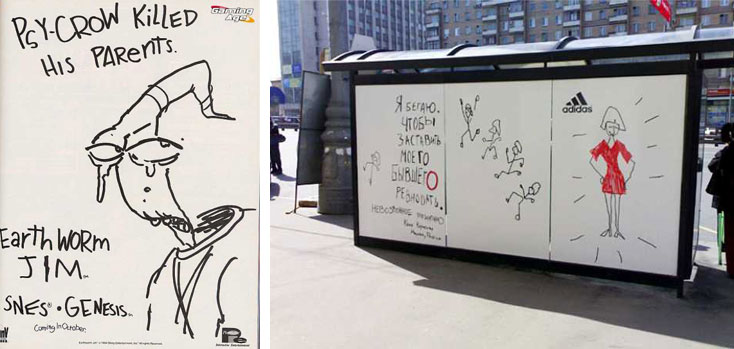
what a fresh and bold approach ... adidas - 2007, shiny entertainment - 1994
The origins of most modern trends and genres are unusually simple: the “glamor” genre is an in-depth retouch of initially bad photographs taken with the participation of bad stylists and mediocre models by curvature photographers. Just a few years - and now we can hardly imagine portraits without silly facial expressions and deep retouching, which does not preserve any signs of life on the face. And only a few, large brands, expensive magazines do it differently. Why? Yes, because to make a subtle, inconspicuous retouch you need a good picture and good knowledge of the anatomy, this is more difficult than writing a portrait. While a “glamorous” retouch can be taught to anyone in three hours. The main thing is not to lubricate the nose and eyes! The rest will drive for style ...
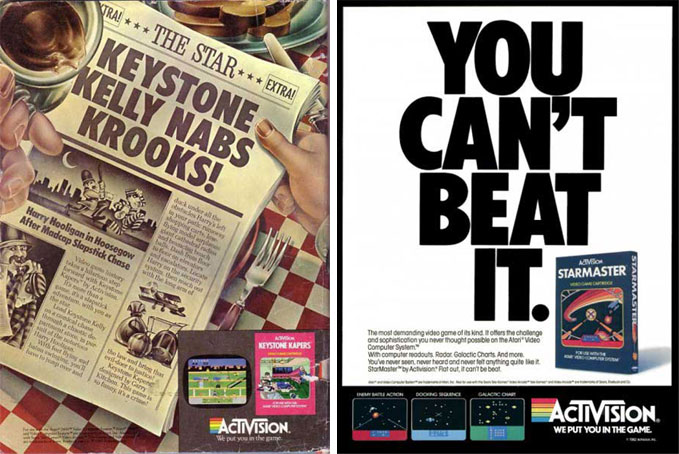
1990s ad units
The grunge genre is collages made of bad materials, the tech design trend is the gloss that is induced by hopelessness - rendering in Photoshop from pictures stolen from the Internet is a technique that anyone can easily master in 3 months. The highest peak is to read two chapters from a drawing textbook - with regard to chiaroscuro and glare. Do you know that the average age of excellent technical designers (including those fashionable and popular on the Internet) is 19-22 years old? Wet floor, diagonal highlights and gradients for everything in a row - the quintessence of what is now fashionable to call “web-style two -zero".
The situation in visual identification is even worse.
Looking back at classic logos? The time when the Apple logo could become recognizable has passed. We love and remember the Coca-Cola lettering, because we see it daily from early childhood. Most often, even designers forget to think about it. I’ll tell you a secret - it’s worth taking a closer look at any logo customary for many years — a bounty there, or a tick from a professional point of view, and you notice that this is a very poor-quality work. But we are so used to it that we don’t notice all this. The classic logos listed in each marketing textbook are far from always good, they are just familiar.

correct shadows and beautiful “icons”, which again became a trend in technical design about 7 years ago
A square or a circle as a logo is very cool minimalism, but it has no chance to stand out, be remembered ...
Designers and art directors are locked in their own society and circle, they dream of an ideal world - their best work is for ideal people ... Ordinary people their just will not notice! The subtleties and nuances in the ligatures of the logoized name are available only to those who understood what was written at the beginning of the sentence ...

paranoid restyling of the “first national”
So, we try, we do a perfect, wonderful job, but we don’t notice it? Exactly! The best brand identification system is such that it can be overlooked, but at the same time, one cannot but recognize and cannot be confused, even subconsciously.
Conscious marketing and advertising for over a hundred years. But just twenty years ago, no one could have thought that the images of visual communication would go beyond leaflets and print ads in newspapers and move to TV, the Internet, electronic displays, and flash movies. Even full-color printing was not so long ago a difficult and expensive process, no one had heard of four-color printing presses then ... Not so long ago, the logo was the symbol that could be drawn in 3 seconds and distributed by any kind of printing on any material. Like a stamp. Something simple, technological.
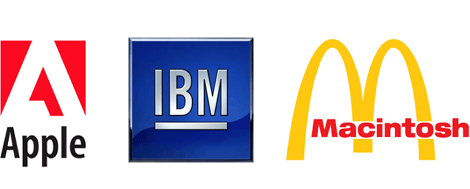
A similar situation is happening in the minds of the average consumer ...
Today, modern methods of communication, the Internet, video, allow goods to have an image that reveals itself using the most rich methods of visual transmission of information. Logo, color and font are an infinitely small part of the visual brand identification system in modern competitive conditions. Globalization and the merger of large markets present new requirements for brand recognition and internal content. The standards of visual identification are becoming comprehensive, they define the key principles of stylistic and ideological unity of all visual aspects of brand communication.
And, most importantly, in the “beautiful new world” - the market is saturated with visual images of brands so much that to compete on it has become a very difficult task. And this is just the tip of the iceberg. In Ukraine, there is no visual culture of branding. Most logos and identification systems openly copy Western designs or even their closest competitors. Every day, the consumer is buried under a wave of visual garbage - the product of the life of unskilled designers and narrow-minded marketers. All this reduces the receptive level of the selective perception filter, or, in simple terms, makes a person ignore 90% of the efforts to identify a brand.
Another common and dangerous trend is unfounded branding - the introduction of a new style and a higher level of guarantees and promises without any changes in the real work of the business. Life example: standing in a stuffy room, in a 40-degree heat, without air conditioning and a fan, waiting in line at the cash register for 30 minutes, knowing that a boorish cashier will meet you in the window, it is difficult to perceive the projection of a warm and friendly image of Nadra Bank. And for some reason I don’t even want to follow the appeal on the poster “if you think that the level of service does not correspond to the level of quality and service, please contact the head of the department and you will have a pleasant surprise.” I saw this boss repeatedly. No pleasant surprises can be expected from her ...
- All never ceases to be surprised.
Since when did the change of logo and corporate identity
begin to be called rebranding?
- since then, when our businessmen competently
priced competitors (without markups of 100-200%),
they started calling them “dumping” :)
(from comments on adme.ru website)
From most of their fellow designers, branding consultants over the years I hear, in fact, the same thing: in our country (and in Russia in general) there is no visual identification, there is no visual branding - there is only a “corporate identity”. My corporate identity is a striped shirt. And mine is all red! And mine - that's how he is ...
Compare the sound of the words "Corporate Identity" and "System of standards for visual brand identification." There is a difference? The first is the design “feint with ears”, the style of the new collection is dresses from garbage bags. The second is the declaration of a system of standards, rules, norms, restrictions and techniques.
The word "brand book" has become no less "obscene" today. Along with the word "brand" is a term that explains in different ways everyone who uses it. The word "brand book" often means everything in the world. In Ukraine, for example, nobody needs a collection of original mock-ups and two blah-blah pages from authors. Abroad - the “brand book” - a lot of “blah blah” about the essence of the brand, its internal idea, the approach to creative work with the brand, the nature of graphics and communications, decorated with colorful pictures. In Odessa (purely regional specificity) - the development of standards for visual identification (apparently so as not to use the phrase "corporate identity"), sometimes it comes to the "clinic": "Can you make us a brand book? Well, as it should, with the name, with the logo, with corporate colors? ... ".
The developers themselves are afraid to use an alternative to this term - “a guide for the implementation of visual identification standards”, “a guide for brand visualization for designers” - it is clear that these are serious documents, the writing of which requires no less effort than writing a good textbook. It is clear that this can not be done for 5 000 UAH. But the market requires affordable prices ...
Increasingly, the logo is losing its dominant role at the top of the chain of graphic images. The era of branding only food products and financial institutions has passed. More and more tasks arise in the service sector, trade, information-intensive industries. Where the logo in its pure form is extremely rare in visual communication. Yes, according to the tradition bordering on the ritual, they put it in the corner or on the back of the flyer, it hangs in the right corner of the video, and on the bottom line of the billboard is small, forgotten, unnecessary. And for food, it almost lost its meaning - logos are everywhere, brands, sub-brands, satelites, generics - five logos per package, 100 - per shelf in a supermarket. Any specialist in FMCG branding will tell you that the consumer has long perceived the packaging of the whole product - a color spot.
The era of the “pure sign” is passing rapidly - trying to save an old friend, designers hang glass effects on it, glare, shadows, gradients - trying to extend his life. Even the giant "Apple" did not escape this fate, confirming the well-known thesis that, created today, this logo would not work ...
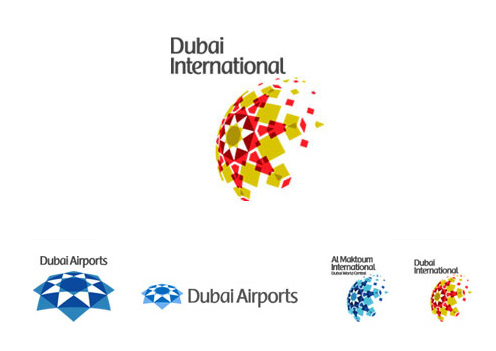
Dubai International Airports
Branding has other requirements for logos of the new generation - plasticity, natural dynamism (everyone is tired of being sucked from a finger animation in logos in which it is not provided - but video, flash and other media require dynamics from the logo), the convenience of adjusting to any composition, without losing the role of the mark in it ...
The train of simple forms left a long time ago. Twenty years ago, probably, they issued a patent for the last standing wicker. All further experiments in this area are a deliberate failure of the task of creating recognizability and competition of images.

All logos were created in 2008, yeah :)
That's why I say goodbye, familiar logo. The new generation logo is completely different. Often, it is three-dimensional, often it is a non-existent figure or a figure with a complex topology - there is only one thing in common - it is easily captured, recognized and does not look far-fetched.

“Goodbye, familiar logo” - restyling telenor - Wollf & Oliins
We often say “a modern visual brand identification system must be integrated and cross-cutting,” but what does this mean in practice? In general, everything is simple - the end-to-end identity is all-pervasive - it is plastic, easily transformed for the needs of any visual, appeal. A system of images and rules is sufficient and redundant, which does not supplant meaning, but it is not lost either. To better understand what this means, let's look at common mistakes.
A sure sign of a bad logo is a self-sufficient, proud badge that rejects any neighborhood that feels comfortable only in the middle of a large white sheet.
A sure sign of the presence of a "corporate identity" is when all that a designer can do is stick a logo on the entire sheet, cut it or duplicate it, making it a "watermark". Twice or thrice, even a repeated logo is not an identification system yet.

Corporate identity of Partners International - Panic Design.
If you remove “graphic garbage” from it in the form of a repeating logo on the background and a yellow strip, the logo will remain in the left corner.
The corporate color and the corporate block (free applications for the “no less corporate” style) - how much of these sounds are for the heart of a Russian ... For starters - about the concept of the “corporate block” - everything is simple and clear here - put the logo, addresses from phone, some strip with a ruffle and sketch on all the layouts. Ctrl + C, Ctrl + V - simple, convenient, corporate, stylish ... Does this help to create a stable identification system - hardly ... A consumer learns to ignore such a block instantly - a selective filter, a white spot on the retina, if you want. The same story about the logo in the left corner, well-known in design circles.
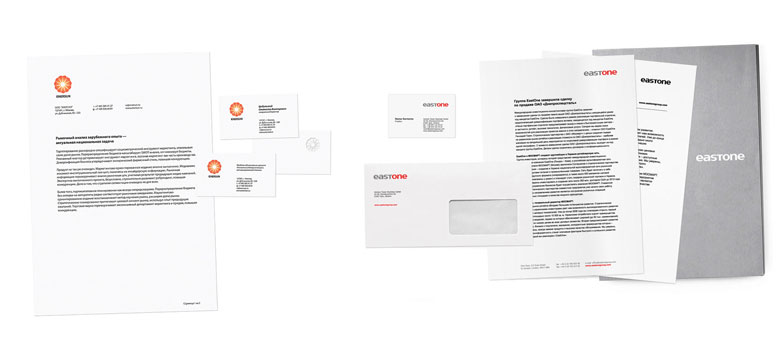
Enersun - studio JollyForm; EastOne - KARANDASH DESIGN

AN Onyx Group - Guess Who Design Band; Alternative rebranding of Russian Railways - Oleg Lukyanov
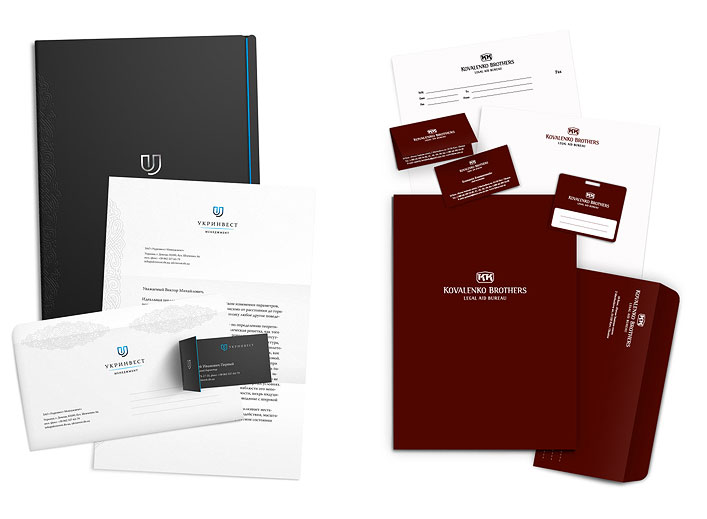
Ukrinvest - Artemy Lebedev Studio; Kovalenko Brothers - Mikhail Mukovoz Studio
Every young designer sooner or later comprehends the great Tao - he fills the entire sheet with red color and puts a small white logo on it, or fills the sheet with green color - and the logo makes gold - it makes no difference, the main thing that looks indescribable cool: concise, restrained, stylish. Even the client cannot keep his “aah” ... Only one catch - the corporate color, even when there is a lot of it, is not enough for identification - he does not allow to stand out. On the contrary, it opens the slab above the mass grave of the same victims of the "corporate lack of style."

Urbica - Nile Studio; Union of Young Socialists - Konovalov XCLV
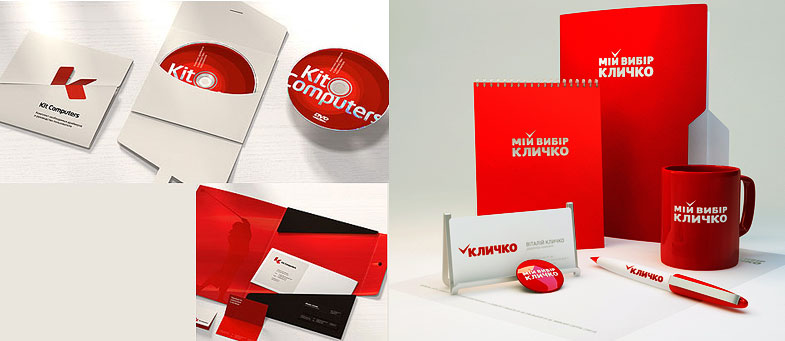
Kit Computers - Lobachev; Brand Klitschko - Konovalov XCLV

You won’t compete with grandees ... Cola-Cola - Turner Duckworth
Or rounded corners, another painful trend in modern design.

TEL - Nile Studio; Hitec - Artemy Lebedev Studio; mcg - The Consult
One of the most important tasks of a modern visual identification system is to make all its elements, starting with the logo, meaningful and applicable. The situation when the sign should be large and the main thing in the composition, otherwise it is not needed and cannot be seen, should not arise in principle. Also with secondary elements - they have no place at the back of the composition. I call it the "organic system."

djuice - Wollf & Oliins

Ease of adjusting the elements of the sign to the composition,
djuice - Wollf & Oliins
The task of end-to-end identity is message identification, instant, subconscious, error-free determination of the message’s affiliation, layout, media to a specific brand. That is why any message, any visual should more than 50% consist of elements of an identification system. Primary and secondary elements, characteristic features in layout and fonts, color dominant. In movement, the consumer has 5 seconds to consider the affiliation of the appeal - this is decisive in deciding whether it is interesting to him. It is due to the instant reading of the accessory that the identification system works in terms of the long-term branding effect and the imprint effect. Regardless of whether the respondent is interested in the message, he recalls the brand.
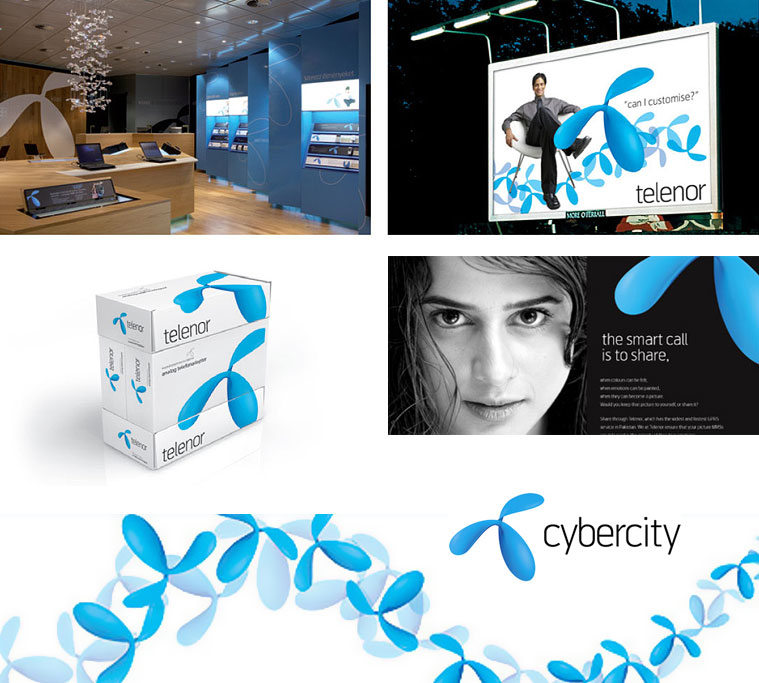
A modern logo as the only sign of visual identification. telenor - Wollf & Oliins

Octonus - Oleg Korshunov, Jam Studio

Octonus - Color coding and the use of corporate-style graphic elements make any printed product recognizable.

Octonus - Oleg Korshunov, Jam Studio
The brand is more primary than the essence of fractional communications. The deeper the penetration of the identification system into the essence of the primary components of visual communication - the better. Simply put, the more simple elements in a layout or video that speaks about a brand, the more significant the victory of designers. Today it’s ridiculous to talk about an identification system that does not describe and does not penetrate website design, video advertising and presentation content. The main thing is not to go too far ...

“They went too far” - Zhitlobud, Art. Lebedev Studio. The identification system easily penetrates into any communication, completely crowding out all the information and common sense from there.

The proof of this is the real billboards I met recently near Kiev. I did not have time to take a picture - I drew from memory.
Palmistry is such a science about reading lines on the hands. It seems like, on the person’s hands are written the whole past, future, all diseases ...
The same palmistry is told by unfortunate marketers and unfortunate designers about their logos - this line symbolizes growth, this spot is our aspirations, and the seagull hints at the elevation of intentions ... It is familiar ?
Understand that the consumer does not want to “read” your logo. He is not going to guess on it, predict fate and calculate the mission of your business. In general, he doesn’t really even want to read your advertising printing, but the logo ... Thank you! The purpose of the visual identification system is not to explain the meaning of the logo. Does a ceramic tile store logo say something about a store, without footage, without captions? Not! The meaning of the logo is to be remembered and cause associations associated with the store! Select a store from the general flow, associate with certain emotions.
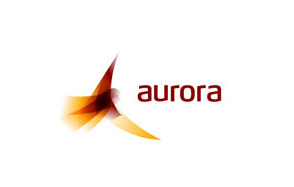
Aurora - KARANDASH Design - try to “read” this logo
It is easy to guess that the image of the phone in the logo will not help easy identification of the telephone company simply because the logo identifies the caption “Uraltelecom Telephone Company,” for example. And if there is no caption in advertising, letterheads and boards, this is a huge mistake. The phone in the logo is just superfluous, it is the right way to get lost among hundreds of other telephones and handsets ...
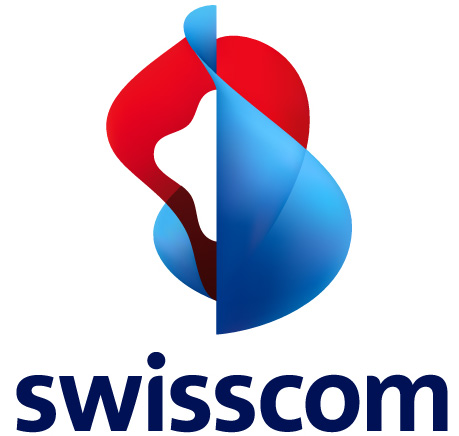
Swisscom - Moving Brands - a telephone company without a phone in the

Swisscom logo - Moving Brands - On the move
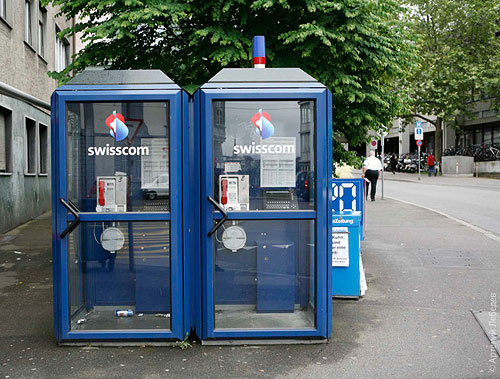
And in life - very noticeable. Photo by Artemy Lebedev.

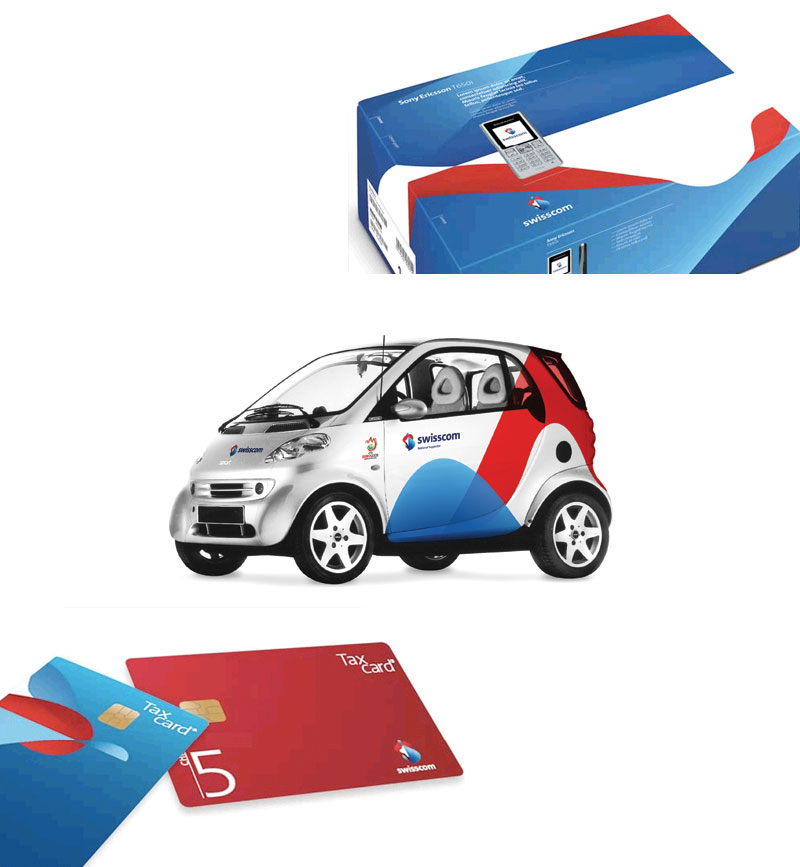
Swisscom Brand Identification - Moving Brands

Swisscom Brand Identification - Moving Brands
Conservatism in approaches to identification has already generated a traditional problem - we remember advertising, but we do not remember what was advertised. The thing is that inside the system of visual standards most often there is no room for imagination. All that a designer can do on these guidelines is to hang a ribbon on top and a strip on the bottom. You can’t catch the consumer, and therefore the main action takes place just between the style-forming elements, pushing them to the second and even third plan - so people get used to not noticing the brand for circulation ...

One of the first breakthroughs in our market was made by the British Wollf & Oliins and their identity Beeline. Extremely simple. Black and yellow stripes, but not at the bottom or top of the layout and not even around the letters - everywhere! On the objects, in the video, on the site, inside the images, in the logo ... A through system, all-pervasive visual signs of the brand. We expected a wave of imitators, but nothing of the kind happened. The Beeline brand has been recognizable for 5 years now.
A similar story happened with the notorious rebranding of UMC in MTS. Having quickly realized the mistakes at the stage of brand launch and eliminated the “egg” emphasis from communication and philosophy, MTS quickly gained momentum and now has perfect recognition. Significantly exceeding recognition of UMC even at the peak of its “promotion”.
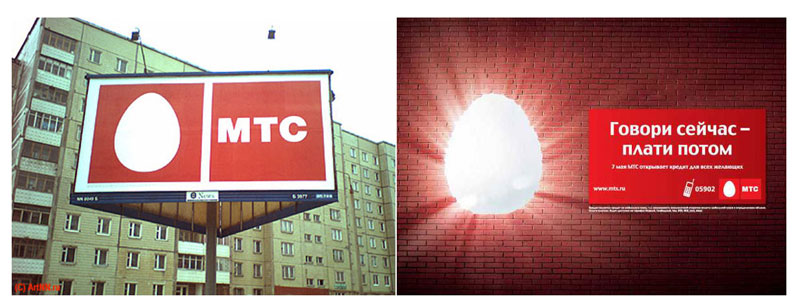
"Egg attack" at the start of rebranding

a significant reduction in the logo in the mock-ups, a shift in emphasis and the introduction of a corporate image in the illustration after the “egg protest”
Both of these examples are textual because the creators of these identification systems did not forget about the scope for imagination.

Unilever by Wolff & Oliins - space for imagination
The client or consumer is the first violin in any marketing orchestra. All efforts are directed at him.
It’s the 21st century in the yard and it’s worth remembering that even before starting work on brand identity, it’s worthwhile to think about where the consumer will encounter our work most often. After all, if this is a small store - then the media - a sign, packaging, price tags, packages - are limited in size and expressive means. If a business is a law office, then living a logo only on business cards and on letterhead with folders is quiet and invisible. And if a large supermarket chain - then who will see her business cards and forms? Billboards, video, Internet, partisan media, interior and exterior, navigation system and corporate magazine are the carriers of style, creating a huge space that we are obliged to use. If the restaurant: carriers - menus, interiors, postcards, company clothes, outdoor advertising.
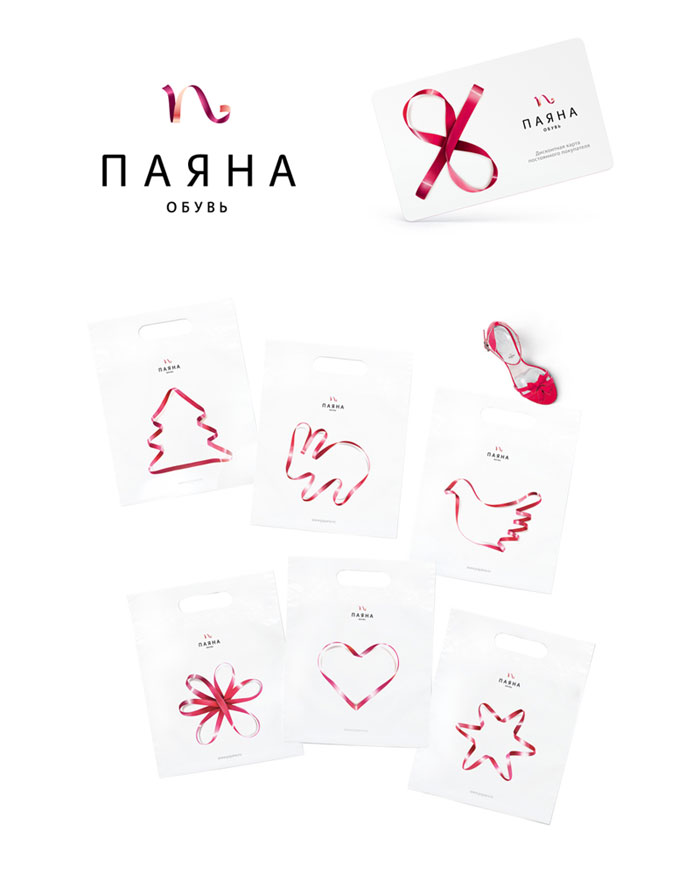
Payana - Artemy Lebedev Studio. The area of application of the identification system - packaging, packages, discount cards, television and the Internet - selected plastic, full-color, material image.
Increasingly, tasks arise when a traditional, monochrome logo is not needed in principle. For example, business is conducted online - this is an information portal - a social network. Advertising is only on TV and on rich-media on the network, forms are only electronic for sending by e-mail. Fantasy? Reality!
Understanding the consumer - this means not only knowing and using where we come across it. This is, first of all, to understand what he wants to see. If he doesn’t need your logo and style, if you are the best search engine optimization company in the city, for example, you don’t need to advertise at all. Your customers come on the recommendation - you do not need any identity system. Your identity is you yourself! It is quite possible to limit

yourself to a beautiful inscription on business cards and forms of commercial offers ... Komtek - restyling, ONY studio. The identification system is built with a clear understanding that its main carrier is packaging.

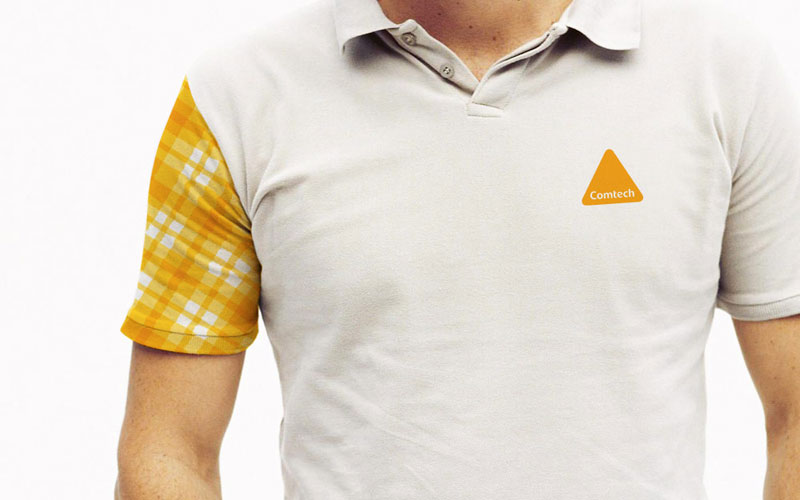
Comtek, ONY Studio - Multicolor pattern as a central element of the identification system. Correct determination of the applicability zone of the identification system.

SonyErricson, Wolff&Oliins — основные признаки стиля — цветовое поле с засветом в центре, шрифт, знак и характерная типографика с использованием знака в качестве символа «люблю».

Woman Journal от Студии Артемия Лебедева — система идентификации описывает материальный мир — „серцем” стиля являются предметы, изготовленные из слоев цветного картона.
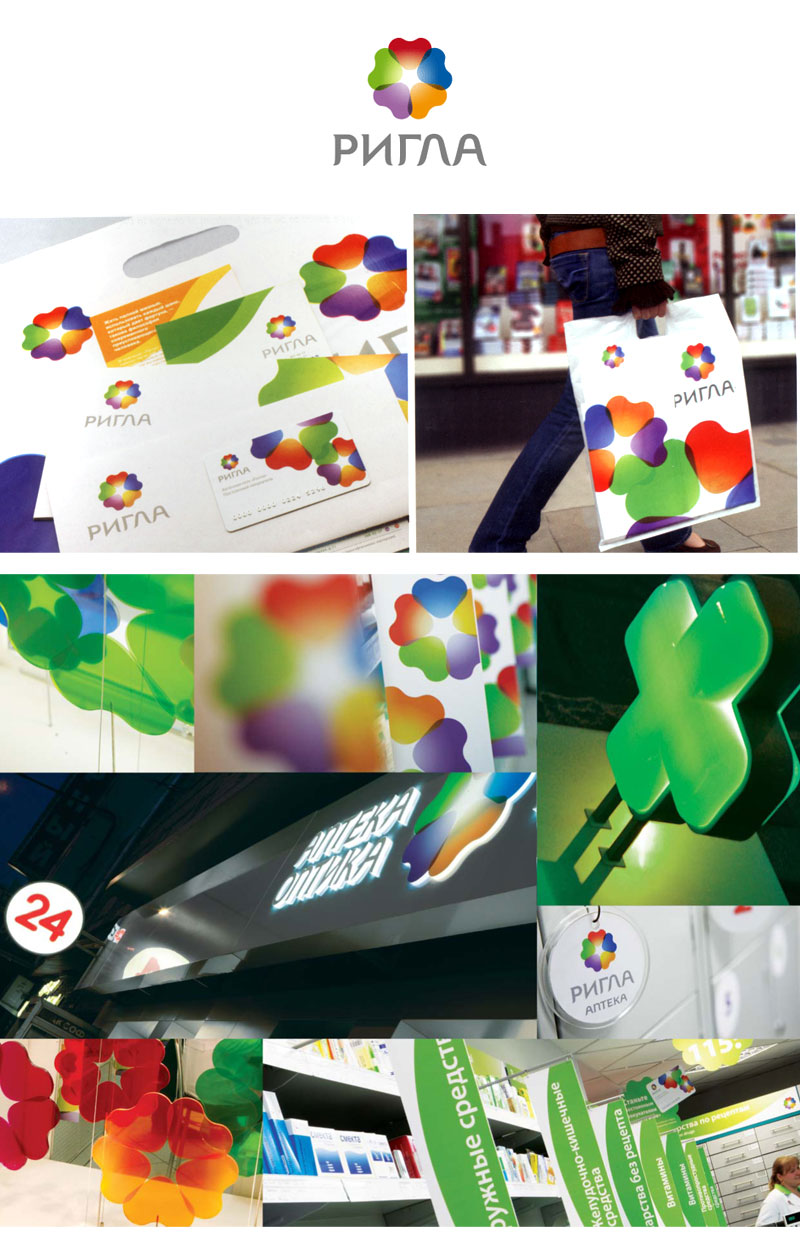
Аптечная сеть Ригла — Identica, achtungdesing. Визуальная идентификация в наружном и внутреннем оформлении
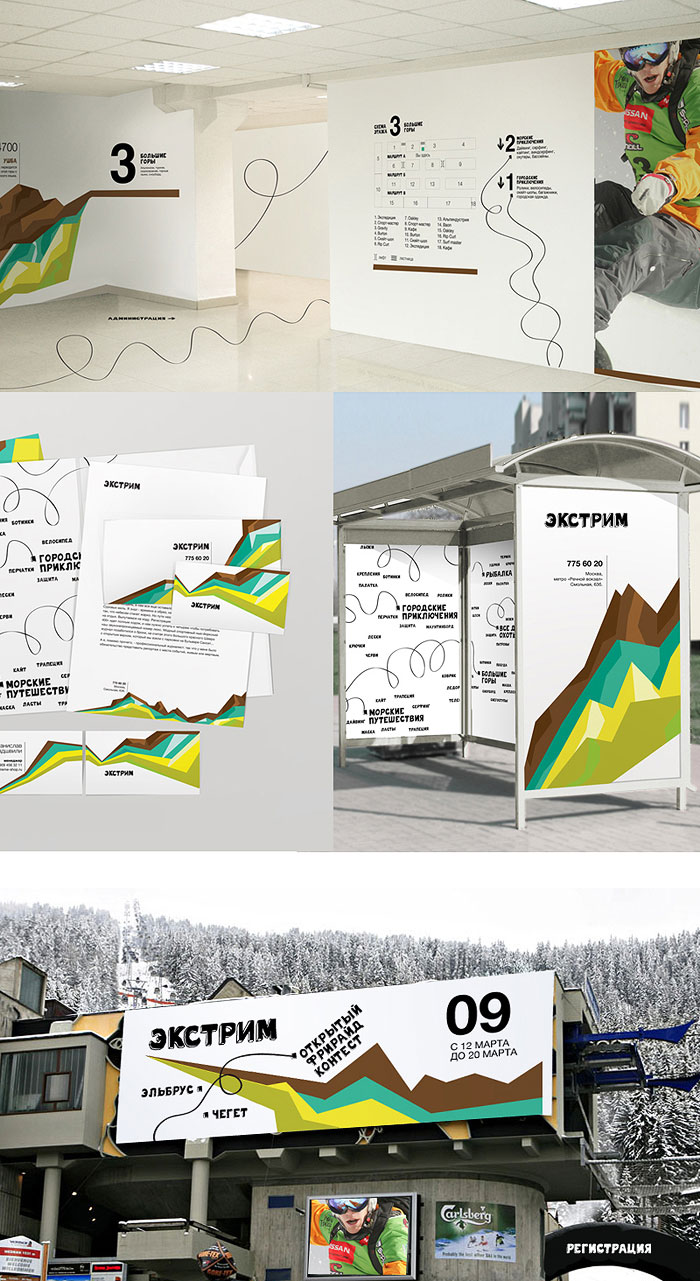
Магазины «Экстрим» — Мелконян Ася, iji-design.
Традиционная функция логотипа потеряна. Логотип растворился в системе идентификации и всем от этого только лучше.

Ресторан Stefan — Александр Озорнин.
Графический паттерн, вместе с основным цветом и текстурой успешно транслируют признаки бренда на любой необходимый носитель

Сеть магазинов Керамацентр — inspire advertising. Логотип свободно чувствует себя на всех основных носителях.
Подход к идентификации, который намеренно превознесен в данной статье, конечно, не является панацеей. Однако автор уверен в том, что время перехода на эти рельсы уже пришло.
Отдельной строкой хочу извиниться перед теми авторами, чьи работы в данной статье приведены, как негативные примеры. Как говорится, отнеситесь к этому, как к одной из точек зрения.
Yaroslav Trofimov , inspire advertising / inspire branding. Specialist in branding and graphic design. Founder and artistic director of inspire advertising. Author and co-author of more than 80 brands, at least 10 of which have brand attributes. Marketing and branding consultant for many large Ukrainian companies. Laureate of the contest “Golden Bee-2008” (nomination for effectiveness), KIAF, Creative Games, etc.

The nature of trends
The world of domestic graphic design and visual branding is symbolic in its pursuit of trends. The tendencies of blind copying and imitation of the incomprehensible dominate in it. Most of the designers, marketers, creators in our country, unfortunately, are people without education and without roots. Everyone can become a prophet in the fatherland if the true nature of things remains open only to units - people who strive for knowledge.
How far we have gone into visual culture, it is easy to see on the examples of print advertising twenty-five years ago.

what a fresh and bold approach ... adidas - 2007, shiny entertainment - 1994
The origins of most modern trends and genres are unusually simple: the “glamor” genre is an in-depth retouch of initially bad photographs taken with the participation of bad stylists and mediocre models by curvature photographers. Just a few years - and now we can hardly imagine portraits without silly facial expressions and deep retouching, which does not preserve any signs of life on the face. And only a few, large brands, expensive magazines do it differently. Why? Yes, because to make a subtle, inconspicuous retouch you need a good picture and good knowledge of the anatomy, this is more difficult than writing a portrait. While a “glamorous” retouch can be taught to anyone in three hours. The main thing is not to lubricate the nose and eyes! The rest will drive for style ...

1990s ad units
The grunge genre is collages made of bad materials, the tech design trend is the gloss that is induced by hopelessness - rendering in Photoshop from pictures stolen from the Internet is a technique that anyone can easily master in 3 months. The highest peak is to read two chapters from a drawing textbook - with regard to chiaroscuro and glare. Do you know that the average age of excellent technical designers (including those fashionable and popular on the Internet) is 19-22 years old? Wet floor, diagonal highlights and gradients for everything in a row - the quintessence of what is now fashionable to call “web-style two -zero".
The situation in visual identification is even worse.
Looking back at classic logos? The time when the Apple logo could become recognizable has passed. We love and remember the Coca-Cola lettering, because we see it daily from early childhood. Most often, even designers forget to think about it. I’ll tell you a secret - it’s worth taking a closer look at any logo customary for many years — a bounty there, or a tick from a professional point of view, and you notice that this is a very poor-quality work. But we are so used to it that we don’t notice all this. The classic logos listed in each marketing textbook are far from always good, they are just familiar.

correct shadows and beautiful “icons”, which again became a trend in technical design about 7 years ago
A square or a circle as a logo is very cool minimalism, but it has no chance to stand out, be remembered ...
Designers and art directors are locked in their own society and circle, they dream of an ideal world - their best work is for ideal people ... Ordinary people their just will not notice! The subtleties and nuances in the ligatures of the logoized name are available only to those who understood what was written at the beginning of the sentence ...

paranoid restyling of the “first national”
So, we try, we do a perfect, wonderful job, but we don’t notice it? Exactly! The best brand identification system is such that it can be overlooked, but at the same time, one cannot but recognize and cannot be confused, even subconsciously.
The world has become different
Conscious marketing and advertising for over a hundred years. But just twenty years ago, no one could have thought that the images of visual communication would go beyond leaflets and print ads in newspapers and move to TV, the Internet, electronic displays, and flash movies. Even full-color printing was not so long ago a difficult and expensive process, no one had heard of four-color printing presses then ... Not so long ago, the logo was the symbol that could be drawn in 3 seconds and distributed by any kind of printing on any material. Like a stamp. Something simple, technological.

A similar situation is happening in the minds of the average consumer ...
Today, modern methods of communication, the Internet, video, allow goods to have an image that reveals itself using the most rich methods of visual transmission of information. Logo, color and font are an infinitely small part of the visual brand identification system in modern competitive conditions. Globalization and the merger of large markets present new requirements for brand recognition and internal content. The standards of visual identification are becoming comprehensive, they define the key principles of stylistic and ideological unity of all visual aspects of brand communication.
And, most importantly, in the “beautiful new world” - the market is saturated with visual images of brands so much that to compete on it has become a very difficult task. And this is just the tip of the iceberg. In Ukraine, there is no visual culture of branding. Most logos and identification systems openly copy Western designs or even their closest competitors. Every day, the consumer is buried under a wave of visual garbage - the product of the life of unskilled designers and narrow-minded marketers. All this reduces the receptive level of the selective perception filter, or, in simple terms, makes a person ignore 90% of the efforts to identify a brand.
Another common and dangerous trend is unfounded branding - the introduction of a new style and a higher level of guarantees and promises without any changes in the real work of the business. Life example: standing in a stuffy room, in a 40-degree heat, without air conditioning and a fan, waiting in line at the cash register for 30 minutes, knowing that a boorish cashier will meet you in the window, it is difficult to perceive the projection of a warm and friendly image of Nadra Bank. And for some reason I don’t even want to follow the appeal on the poster “if you think that the level of service does not correspond to the level of quality and service, please contact the head of the department and you will have a pleasant surprise.” I saw this boss repeatedly. No pleasant surprises can be expected from her ...
Curse words
- All never ceases to be surprised.
Since when did the change of logo and corporate identity
begin to be called rebranding?
- since then, when our businessmen competently
priced competitors (without markups of 100-200%),
they started calling them “dumping” :)
(from comments on adme.ru website)
From most of their fellow designers, branding consultants over the years I hear, in fact, the same thing: in our country (and in Russia in general) there is no visual identification, there is no visual branding - there is only a “corporate identity”. My corporate identity is a striped shirt. And mine is all red! And mine - that's how he is ...
Compare the sound of the words "Corporate Identity" and "System of standards for visual brand identification." There is a difference? The first is the design “feint with ears”, the style of the new collection is dresses from garbage bags. The second is the declaration of a system of standards, rules, norms, restrictions and techniques.
The word "brand book" has become no less "obscene" today. Along with the word "brand" is a term that explains in different ways everyone who uses it. The word "brand book" often means everything in the world. In Ukraine, for example, nobody needs a collection of original mock-ups and two blah-blah pages from authors. Abroad - the “brand book” - a lot of “blah blah” about the essence of the brand, its internal idea, the approach to creative work with the brand, the nature of graphics and communications, decorated with colorful pictures. In Odessa (purely regional specificity) - the development of standards for visual identification (apparently so as not to use the phrase "corporate identity"), sometimes it comes to the "clinic": "Can you make us a brand book? Well, as it should, with the name, with the logo, with corporate colors? ... ".
The developers themselves are afraid to use an alternative to this term - “a guide for the implementation of visual identification standards”, “a guide for brand visualization for designers” - it is clear that these are serious documents, the writing of which requires no less effort than writing a good textbook. It is clear that this can not be done for 5 000 UAH. But the market requires affordable prices ...
Goodbye familiar logo
Increasingly, the logo is losing its dominant role at the top of the chain of graphic images. The era of branding only food products and financial institutions has passed. More and more tasks arise in the service sector, trade, information-intensive industries. Where the logo in its pure form is extremely rare in visual communication. Yes, according to the tradition bordering on the ritual, they put it in the corner or on the back of the flyer, it hangs in the right corner of the video, and on the bottom line of the billboard is small, forgotten, unnecessary. And for food, it almost lost its meaning - logos are everywhere, brands, sub-brands, satelites, generics - five logos per package, 100 - per shelf in a supermarket. Any specialist in FMCG branding will tell you that the consumer has long perceived the packaging of the whole product - a color spot.
The era of the “pure sign” is passing rapidly - trying to save an old friend, designers hang glass effects on it, glare, shadows, gradients - trying to extend his life. Even the giant "Apple" did not escape this fate, confirming the well-known thesis that, created today, this logo would not work ...

Dubai International Airports
Branding has other requirements for logos of the new generation - plasticity, natural dynamism (everyone is tired of being sucked from a finger animation in logos in which it is not provided - but video, flash and other media require dynamics from the logo), the convenience of adjusting to any composition, without losing the role of the mark in it ...
The train of simple forms left a long time ago. Twenty years ago, probably, they issued a patent for the last standing wicker. All further experiments in this area are a deliberate failure of the task of creating recognizability and competition of images.

All logos were created in 2008, yeah :)
That's why I say goodbye, familiar logo. The new generation logo is completely different. Often, it is three-dimensional, often it is a non-existent figure or a figure with a complex topology - there is only one thing in common - it is easily captured, recognized and does not look far-fetched.

“Goodbye, familiar logo” - restyling telenor - Wollf & Oliins
End-to-end visual identification system - what is it?
We often say “a modern visual brand identification system must be integrated and cross-cutting,” but what does this mean in practice? In general, everything is simple - the end-to-end identity is all-pervasive - it is plastic, easily transformed for the needs of any visual, appeal. A system of images and rules is sufficient and redundant, which does not supplant meaning, but it is not lost either. To better understand what this means, let's look at common mistakes.
A sure sign of a bad logo is a self-sufficient, proud badge that rejects any neighborhood that feels comfortable only in the middle of a large white sheet.
A sure sign of the presence of a "corporate identity" is when all that a designer can do is stick a logo on the entire sheet, cut it or duplicate it, making it a "watermark". Twice or thrice, even a repeated logo is not an identification system yet.

Corporate identity of Partners International - Panic Design.
If you remove “graphic garbage” from it in the form of a repeating logo on the background and a yellow strip, the logo will remain in the left corner.
The corporate color and the corporate block (free applications for the “no less corporate” style) - how much of these sounds are for the heart of a Russian ... For starters - about the concept of the “corporate block” - everything is simple and clear here - put the logo, addresses from phone, some strip with a ruffle and sketch on all the layouts. Ctrl + C, Ctrl + V - simple, convenient, corporate, stylish ... Does this help to create a stable identification system - hardly ... A consumer learns to ignore such a block instantly - a selective filter, a white spot on the retina, if you want. The same story about the logo in the left corner, well-known in design circles.

Enersun - studio JollyForm; EastOne - KARANDASH DESIGN

AN Onyx Group - Guess Who Design Band; Alternative rebranding of Russian Railways - Oleg Lukyanov

Ukrinvest - Artemy Lebedev Studio; Kovalenko Brothers - Mikhail Mukovoz Studio
Every young designer sooner or later comprehends the great Tao - he fills the entire sheet with red color and puts a small white logo on it, or fills the sheet with green color - and the logo makes gold - it makes no difference, the main thing that looks indescribable cool: concise, restrained, stylish. Even the client cannot keep his “aah” ... Only one catch - the corporate color, even when there is a lot of it, is not enough for identification - he does not allow to stand out. On the contrary, it opens the slab above the mass grave of the same victims of the "corporate lack of style."

Urbica - Nile Studio; Union of Young Socialists - Konovalov XCLV

Kit Computers - Lobachev; Brand Klitschko - Konovalov XCLV

You won’t compete with grandees ... Cola-Cola - Turner Duckworth
Or rounded corners, another painful trend in modern design.

TEL - Nile Studio; Hitec - Artemy Lebedev Studio; mcg - The Consult
One of the most important tasks of a modern visual identification system is to make all its elements, starting with the logo, meaningful and applicable. The situation when the sign should be large and the main thing in the composition, otherwise it is not needed and cannot be seen, should not arise in principle. Also with secondary elements - they have no place at the back of the composition. I call it the "organic system."

djuice - Wollf & Oliins

Ease of adjusting the elements of the sign to the composition,
djuice - Wollf & Oliins
The task of end-to-end identity is message identification, instant, subconscious, error-free determination of the message’s affiliation, layout, media to a specific brand. That is why any message, any visual should more than 50% consist of elements of an identification system. Primary and secondary elements, characteristic features in layout and fonts, color dominant. In movement, the consumer has 5 seconds to consider the affiliation of the appeal - this is decisive in deciding whether it is interesting to him. It is due to the instant reading of the accessory that the identification system works in terms of the long-term branding effect and the imprint effect. Regardless of whether the respondent is interested in the message, he recalls the brand.

A modern logo as the only sign of visual identification. telenor - Wollf & Oliins

Octonus - Oleg Korshunov, Jam Studio

Octonus - Color coding and the use of corporate-style graphic elements make any printed product recognizable.

Octonus - Oleg Korshunov, Jam Studio
The brand is more primary than the essence of fractional communications. The deeper the penetration of the identification system into the essence of the primary components of visual communication - the better. Simply put, the more simple elements in a layout or video that speaks about a brand, the more significant the victory of designers. Today it’s ridiculous to talk about an identification system that does not describe and does not penetrate website design, video advertising and presentation content. The main thing is not to go too far ...

“They went too far” - Zhitlobud, Art. Lebedev Studio. The identification system easily penetrates into any communication, completely crowding out all the information and common sense from there.

The proof of this is the real billboards I met recently near Kiev. I did not have time to take a picture - I drew from memory.
The decisive “no” of palmistry.
Palmistry is such a science about reading lines on the hands. It seems like, on the person’s hands are written the whole past, future, all diseases ...
The same palmistry is told by unfortunate marketers and unfortunate designers about their logos - this line symbolizes growth, this spot is our aspirations, and the seagull hints at the elevation of intentions ... It is familiar ?
Understand that the consumer does not want to “read” your logo. He is not going to guess on it, predict fate and calculate the mission of your business. In general, he doesn’t really even want to read your advertising printing, but the logo ... Thank you! The purpose of the visual identification system is not to explain the meaning of the logo. Does a ceramic tile store logo say something about a store, without footage, without captions? Not! The meaning of the logo is to be remembered and cause associations associated with the store! Select a store from the general flow, associate with certain emotions.

Aurora - KARANDASH Design - try to “read” this logo
It is easy to guess that the image of the phone in the logo will not help easy identification of the telephone company simply because the logo identifies the caption “Uraltelecom Telephone Company,” for example. And if there is no caption in advertising, letterheads and boards, this is a huge mistake. The phone in the logo is just superfluous, it is the right way to get lost among hundreds of other telephones and handsets ...

Swisscom - Moving Brands - a telephone company without a phone in the

Swisscom logo - Moving Brands - On the move

And in life - very noticeable. Photo by Artemy Lebedev.


Swisscom Brand Identification - Moving Brands

Swisscom Brand Identification - Moving Brands
Outdoor for fantasy
Conservatism in approaches to identification has already generated a traditional problem - we remember advertising, but we do not remember what was advertised. The thing is that inside the system of visual standards most often there is no room for imagination. All that a designer can do on these guidelines is to hang a ribbon on top and a strip on the bottom. You can’t catch the consumer, and therefore the main action takes place just between the style-forming elements, pushing them to the second and even third plan - so people get used to not noticing the brand for circulation ...

One of the first breakthroughs in our market was made by the British Wollf & Oliins and their identity Beeline. Extremely simple. Black and yellow stripes, but not at the bottom or top of the layout and not even around the letters - everywhere! On the objects, in the video, on the site, inside the images, in the logo ... A through system, all-pervasive visual signs of the brand. We expected a wave of imitators, but nothing of the kind happened. The Beeline brand has been recognizable for 5 years now.
A similar story happened with the notorious rebranding of UMC in MTS. Having quickly realized the mistakes at the stage of brand launch and eliminated the “egg” emphasis from communication and philosophy, MTS quickly gained momentum and now has perfect recognition. Significantly exceeding recognition of UMC even at the peak of its “promotion”.

"Egg attack" at the start of rebranding

a significant reduction in the logo in the mock-ups, a shift in emphasis and the introduction of a corporate image in the illustration after the “egg protest”
Both of these examples are textual because the creators of these identification systems did not forget about the scope for imagination.

Unilever by Wolff & Oliins - space for imagination
Learning to understand the client
The client or consumer is the first violin in any marketing orchestra. All efforts are directed at him.
It’s the 21st century in the yard and it’s worth remembering that even before starting work on brand identity, it’s worthwhile to think about where the consumer will encounter our work most often. After all, if this is a small store - then the media - a sign, packaging, price tags, packages - are limited in size and expressive means. If a business is a law office, then living a logo only on business cards and on letterhead with folders is quiet and invisible. And if a large supermarket chain - then who will see her business cards and forms? Billboards, video, Internet, partisan media, interior and exterior, navigation system and corporate magazine are the carriers of style, creating a huge space that we are obliged to use. If the restaurant: carriers - menus, interiors, postcards, company clothes, outdoor advertising.

Payana - Artemy Lebedev Studio. The area of application of the identification system - packaging, packages, discount cards, television and the Internet - selected plastic, full-color, material image.
Increasingly, tasks arise when a traditional, monochrome logo is not needed in principle. For example, business is conducted online - this is an information portal - a social network. Advertising is only on TV and on rich-media on the network, forms are only electronic for sending by e-mail. Fantasy? Reality!
Understanding the consumer - this means not only knowing and using where we come across it. This is, first of all, to understand what he wants to see. If he doesn’t need your logo and style, if you are the best search engine optimization company in the city, for example, you don’t need to advertise at all. Your customers come on the recommendation - you do not need any identity system. Your identity is you yourself! It is quite possible to limit

yourself to a beautiful inscription on business cards and forms of commercial offers ... Komtek - restyling, ONY studio. The identification system is built with a clear understanding that its main carrier is packaging.


Comtek, ONY Studio - Multicolor pattern as a central element of the identification system. Correct determination of the applicability zone of the identification system.

SonyErricson, Wolff&Oliins — основные признаки стиля — цветовое поле с засветом в центре, шрифт, знак и характерная типографика с использованием знака в качестве символа «люблю».

Woman Journal от Студии Артемия Лебедева — система идентификации описывает материальный мир — „серцем” стиля являются предметы, изготовленные из слоев цветного картона.

Аптечная сеть Ригла — Identica, achtungdesing. Визуальная идентификация в наружном и внутреннем оформлении

Магазины «Экстрим» — Мелконян Ася, iji-design.
Традиционная функция логотипа потеряна. Логотип растворился в системе идентификации и всем от этого только лучше.

Ресторан Stefan — Александр Озорнин.
Графический паттерн, вместе с основным цветом и текстурой успешно транслируют признаки бренда на любой необходимый носитель

Сеть магазинов Керамацентр — inspire advertising. Логотип свободно чувствует себя на всех основных носителях.
Вместо эпилога
Подход к идентификации, который намеренно превознесен в данной статье, конечно, не является панацеей. Однако автор уверен в том, что время перехода на эти рельсы уже пришло.
Отдельной строкой хочу извиниться перед теми авторами, чьи работы в данной статье приведены, как негативные примеры. Как говорится, отнеситесь к этому, как к одной из точек зрения.
Об авторе
Yaroslav Trofimov , inspire advertising / inspire branding. Specialist in branding and graphic design. Founder and artistic director of inspire advertising. Author and co-author of more than 80 brands, at least 10 of which have brand attributes. Marketing and branding consultant for many large Ukrainian companies. Laureate of the contest “Golden Bee-2008” (nomination for effectiveness), KIAF, Creative Games, etc.
